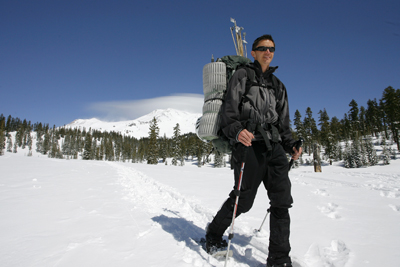|
Mount Shasta just one more peak for this climber
 |
Zach Urness/Daily Courier
Rogue River High graduate Brian Dickinson is an expert in Mountaineering and is in the process of climbing the world's "Seven Summits" -- the tallest peak on each continent. |
Rogue River High graduate Brian Dickinson is on a quest to climb the "Seven Summits," a journey that will take him to the highest point on each of the world's seven continents. I sat down with him to discuss his plan along with how to survive on the mountain. Here’s a video of myself and Brian climbing Mount Shasta. o o o oBy Zach Urness of the Daily CourierBrian Dickinson needed a hobby.After six years as a U.S. Navy helicopter search and rescue swimmer, the 1992 Rogue River High graduate settled down in Snoqualmie, Wash., to raise a family with his wife JoAnna. Now, what to do with his free time? Play golf? Nope. Shoot pool? Nah. Ultimate frisbee? As it turns out, not ultimate enough. Then Dickinson looked at the ridge of Cascade Mountains outside his window and asked: "Hey, why not climb them?" And so the new hobby was set in motion. "I've always been into extreme adventures," Dickinson said. "Living in the middle of the Cascades was just a big temptation." Since that moment, Dickinson's been at home in the thin air. He's in the process of climbing the "Seven Summits," a journey that will take him to the highest point on each of the world's seven continents. The first legs of his journey haven't been without incident. Last May, he climbed North America's tallest point — Mount McKinley (also known as Denali) — and was pinned down at high camp (17,000 feet) for five days due to 60-mph winds and temperatures that dropped 30 degrees below zero. Two people died while he was on the mountain, including one person who had a heart attack and another who made an unsafe attempt at the summit. "One of our members was blown 100 feet off the mountain, taking the other two on her rope team with her," Dickinson said. "Only their quick diligence in performing a self-arrest saved their lives." With Africa's Mount Kilimanjaro (19,341 feet) under his belt, he's planning to climb two more peaks before attempting Mount Everest (29,029 feet) in May 2011. He's working to raise funds for the trip as well as AIDS research. In his free time — he works for Cisco Systems — Dickinson leads a group called Extreme Adventures on climbs throughout the Pacific Northwest. This past Saturday, Dickinson joined the Daily Courier's Zach Urness on a climb to Mount Shasta. During the trip, Dickinson provided insight on a number of important questions for those interested in reaching their own mountain tops. Daily Courier: When you decide to climb a mountain above 10,000 feet, what's the most important thing to know beforehand? Brian Dickinson: It's very important to research the weather and avalanche conditions when planning a climb. Knowing your personal limitations and not exceeding them may be the difference between a successful climb and avoiding altitude or physical issues. Having solid mountaineering skills or climbing with seasoned veterans also is important since conditions can change very quickly high on the mountain. DC: What is altitude sickness and how can it affect you? BD: Most people feel the affects of altitude around or above 8,000 feet. Altitude sickness is caused by exposure to low partial pressure of oxygen at high altitude. Initial indications of altitude sickness are headaches, nausea, dizziness, weakness, vomiting and general malaise. Doctors can prescribe certain medication like Diamox to help combat altitude sickness. In higher altitudes the conditions can progress to High Altitude Pulmonary Edema (fluid in the lungs) or High Altitude Cerebral Edema (swelling of the brain). In extreme situations the only remedy is to decrease altitude. When moving to high altitude, climbers should acclimate by climbing to higher altitudes in small segments (3,000 feet) and then come back down to rest before moving camp higher. DC: Before you decide to climb a mountain above 10,000 feet, what type of training or baseline fitness level should a person be able to meet? BD: I tend to train for what I'd expect on the mountain. You really can't train for the altitude effects, but you can be aware of your body and plan the climb accordingly, allowing time for acclimation. Prior to the expedition climbing with a heavy pack on a mountain with 3,000 feet of gain two or three times a week is good for building the core. Running six to seven miles in between climbs will help strengthen your cardio. DC: When you're on the mountain, how should you know it's time to turn around? BD: There are a lot of climbers that get into trouble because of their lack of self awareness. They may have invested a lot of time and money so they feel compelled to press on when conditions are bad or they have reached their limits. The summit is the halfway point, meaning you still have to get back down. When you're too tired or feeling the symptoms of altitude sickness, it's probably a good idea to think about stopping or turning back. The mountain will always be there and climbing to the top is no excuse to risk your life. There's no shame in surviving. DC: What are the greatest dangers an inexperienced climber is likely to face? BD: An inexperienced climber won't have the knowledge and experience to use the skills and techniques to efficiently climb the mountain. Ascending a 14,000-foot peak is a lot different than a casual trail climb. Weather conditions and technical routes can also change very quickly, so preparation and confidence is very important to be able to respond appropriately to change. o o o Note: To view video or pictures from Dickinson's climbs, or to make a contribution, visit www.sponsor7summits.com
| 




